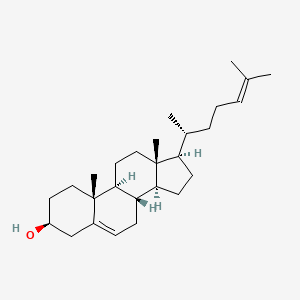| MeSH term | MeSH ID | Detail |
|---|---|---|
| Hemolysis | D006461 | 131 associated lipids |
| Coronary Disease | D003327 | 70 associated lipids |
| Celiac Disease | D002446 | 16 associated lipids |
| Xanthomatosis | D014973 | 17 associated lipids |
| Insulin Resistance | D007333 | 99 associated lipids |
| Limb Deformities, Congenital | D017880 | 4 associated lipids |
DESMOSTEROL
DESMOSTEROL is a lipid of Sterol Lipids (ST) class. Desmosterol is associated with abnormalities such as Cataract, Congenital Abnormality, Liver diseases, Erectile dysfunction and Multiple congenital anomalies. The involved functions are known as Bulla, Methylation, cholesterol biosynthetic process, Process and cholesterol efflux. Desmosterol often locates in Body tissue, Tissue membrane, Plasma membrane, Pore and Endoplasmic Reticulum. The associated genes with DESMOSTEROL are P4HTM gene, SHH gene, WDR48 gene, CFLAR gene and SLC33A1 gene. The related lipids are Sterols, androstanol, Steroids, Unilamellar Vesicles and 7-dehydrocholesterol. The related experimental models are Transgenic Model and Rodent Model.
Cross Reference
Introduction
To understand associated biological information of DESMOSTEROL, we collected biological information of abnormalities, associated pathways, cellular/molecular locations, biological functions, related genes/proteins, lipids and common seen animal/experimental models with organized paragraphs from literatures.
What diseases are associated with DESMOSTEROL?
DESMOSTEROL is suspected in Atherosclerosis, Congenital Abnormality, Liver diseases, Fatty Streak, Arterial, Senile Plaques, Coronary Arteriosclerosis and other diseases in descending order of the highest number of associated sentences.
Related references are mostly published in these journals:
| Disease | Cross reference | Weighted score | Related literature |
|---|
Possible diseases from mapped MeSH terms on references
We collected disease MeSH terms mapped to the references associated with DESMOSTEROL
PubChem Associated disorders and diseases
What pathways are associated with DESMOSTEROL
Lipid pathways are not clear in current pathway databases. We organized associated pathways with DESMOSTEROL through full-text articles, including metabolic pathways or pathways of biological mechanisms.
Related references are published most in these journals:
| Pathway name | Related literatures |
|---|
PubChem Biomolecular Interactions and Pathways
Link to PubChem Biomolecular Interactions and PathwaysWhat cellular locations are associated with DESMOSTEROL?
Visualization in cellular structure
Associated locations are in red color. Not associated locations are in black.
Related references are published most in these journals:
| Location | Cross reference | Weighted score | Related literatures |
|---|
What functions are associated with DESMOSTEROL?
Related references are published most in these journals:
| Function | Cross reference | Weighted score | Related literatures |
|---|
What lipids are associated with DESMOSTEROL?
Related references are published most in these journals:
| Lipid concept | Cross reference | Weighted score | Related literatures |
|---|
What genes are associated with DESMOSTEROL?
Related references are published most in these journals:
| Gene | Cross reference | Weighted score | Related literatures |
|---|
What common seen animal models are associated with DESMOSTEROL?
Transgenic Model
Transgenic Model are used in the study 'Cellular production of n-3 PUFAs and reduction of n-6-to-n-3 ratios in the pancreatic beta-cells and islets enhance insulin secretion and confer protection against cytokine-induced cell death.' (Wei D et al., 2010).
Rodent Model
Rodent Model are used in the study 'Oxidation of 7-dehydrocholesterol and desmosterol by human cytochrome P450 46A1.' (Goyal S et al., 2014).
Related references are published most in these journals:
| Model | Cross reference | Weighted score | Related literatures |
|---|
NCBI Entrez Crosslinks
All references with DESMOSTEROL
Download all related citations| Authors | Title | Published | Journal | PubMed Link |
|---|---|---|---|---|
| Phleger CF et al. | Interannual and between species comparison of the lipids, fatty acids and sterols of Antarctic krill from the US AMLR Elephant Island survey area. | 2002 | Comp. Biochem. Physiol. B, Biochem. Mol. Biol. | pmid:11923086 |
| Phleger CF et al. | Lipid composition of deep-sea hydrothermal vent tubeworm Riftia pachyptila, crabs Munidopsis subsquamosa and Bythograea thermydron, mussels Bathymodiolus sp. and limpets Lepetodrilus spp. | 2005 | Comp. Biochem. Physiol. B, Biochem. Mol. Biol. | pmid:15893489 |
| Phleger CF et al. | Interannual variations in the lipids of the Antarctic pteropods Clione limacina and Clio pyramidata. | 2001 | Comp. Biochem. Physiol. B, Biochem. Mol. Biol. | pmid:11250551 |
| Kwieciński H | Myotonia induced by chemical agents. | 1981 | Crit. Rev. Toxicol. | pmid:7026172 |
| Miller RR et al. | Comparative aspects of sperm membrane fatty acid composition in silver (Vulpes vulpes) and blue (Alopex lagopus) foxes, and their relationship to cell cryopreservation. | 2005 | Cryobiology | pmid:16040024 |
| Miller RR et al. | Sperm membrane fatty acid composition in the Eastern grey kangaroo (Macropus giganteus), koala (Phascolarctos cinereus), and common wombat (Vombatus ursinus) and its relationship to cold shock injury and cryopreservation success. | 2004 | Cryobiology | pmid:15351685 |
| Tansley G et al. | Sterol lipid metabolism in down syndrome revisited: down syndrome is associated with a selective reduction in serum brassicasterol levels. | 2012 | Curr Gerontol Geriatr Res | pmid:22649448 |
| Assmann G et al. | Effects of ezetimibe, simvastatin, atorvastatin, and ezetimibe-statin therapies on non-cholesterol sterols in patients with primary hypercholesterolemia. | 2008 | Curr Med Res Opin | pmid:18053317 |
| Pfeifer T et al. | Synthetic LXR agonist suppresses endogenous cholesterol biosynthesis and efficiently lowers plasma cholesterol. | 2011 | Curr Pharm Biotechnol | pmid:21190543 |
| Weeks AC et al. | Identification and potency of cyclodextrin-lipid inhibitors of Staphylococcus aureus α-toxin. | 2012 | Curr. Eye Res. | pmid:22050601 |
